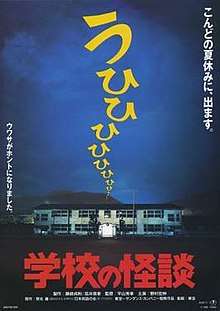School Ghost Stories
School Ghost Stories (学校の怪談, Gakkō no Kaidan) is a 1995 Japanese film directed by Hideyuki Hirayama.[1] The film is the first of the School Ghost Stories features, and was followed by School Ghost Stories 2 in 1996.
| School Ghost Stories | |
|---|---|
 Japanese film poster | |
| Japanese | 学校の怪談 |
| Hepburn | Gakkō no Kaidan |
| Directed by | Hideyuki Hirayama |
| Screenplay by | Satoko Okudera[1] |
| Story by | Toru Tsunemitsu[1] |
| Starring |
|
| Cinematography | Kozo Shibazaki[1] |
| Edited by | Akimasa Kawashima[1] |
Production companies |
|
| Distributed by | Toho |
Release date |
|
Running time | 100 minutes |
| Country | Japan |
| Box office | ¥2.55 billion (Japan) |
Plot
In an elementary school, a girl named Mika disappears mysteriously after following the sound of laughter into the bathroom. She was known to have 2 golden rings that "disappeared" from her tray. The rumors of the school being haunted, strange things happening around 4:44 AM and the disappearance of children soon emerge, but Mika's older sister and her friends decide to go after Mika despite this. They soon find out that all the rumors are true, and now they not only have to find the girl, but also save themselves from the malevolent ghosts that haunt the school building.
Background
In the mid-1980s, a schoolteacher named Toru Tsunemitsu began to share ghost stories with his young students.[2] Tsunemitsu originally began his focus on ghost stories around town, but found an unusually large amount of them centered on school.[2] He began to narrow his focus to school-based ghost stories, and asked his students for them, which led to his receiving over 160 stories in two weeks.[2]
In 1990, the first volume of these stories by Tsunemitsu was released under the title Gakkō no Kaidan.[2] The stories were aimed at children and published by Kodansha and became very popular in Japan.[2] The stories were later adapted into television where they were bought by Kansai Television who televised a six episode miniseries in 1994.[2] In 1995, a film adaptation was made.[2]
Release
School Ghost Stories was released in Japan on July 8, 1995 where it was distributed by Toho.[1] The film is the first of the School Ghost Stories features, and was followed by School Ghost Stories 2 in 1996.[1] School Ghost Stories earned a distribution income of ¥1.5 billion[3] ($14.5 million) in Japan,[4] and reached a total box office gross of ¥2.55 billion[5] ($27.1 million) in Japan.[6]
Reception
David Kalat, author of J-Horror: The Definitive Guide to The Ring, The Grudge and Beyond (2007), described the series as being "packed with two scoops of wild, surrealistic visions, but no real sense of menace. A threadbare and uninteresting plot holds together 100-some minutes' worth of weird but mostly non-threatening spooks."[4]
See also
- Ghost Stories, a later anime adaption
- Kotodama – Spiritual Curse
Notes
- Galbraith IV 2008, p. 390.
- Kalat 2007, p. 55.
- "過去興行収入上位作品". Eiren. Motion Picture Producers Association of Japan. 1995. Retrieved 9 May 2020.
- Kalat 2007, p. 56.
- "邦画興行収入ランキング". SF MOVIE DataBank. General Works. Retrieved 19 February 2019.
- "Official exchange rate (LCU per US$, period average) - Japan". World Bank. 1995. Retrieved 2 May 2020.
References
- Galbraith IV, Stuart (2008). The Toho Studios Story: A History and Complete Filmography. Scarecrow Press. ISBN 1461673747.CS1 maint: ref=harv (link)
- Kalat, David (2007). J-Horror: The Definitive Guide to The Ring, The Grudge and Beyond. Vertical Inc. ISBN 978-1-932234-08-4.CS1 maint: ref=harv (link)
External links